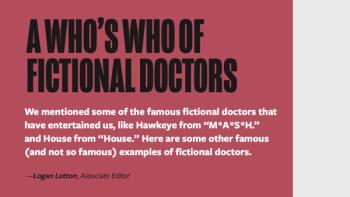
- Medical Economics October 2023
- Volume 100
- Issue 10
How modern medicine was made, part 5: The history of orthopedic surgery and organ transplantation
"Plaster and sticks and casts and traction."
Historians have traced how 19th century surgeons developed the foundation of 20th century orthopedics. By 1923, doctors were adept at using plaster of Paris to immobilize limbs and x-ray machines could see broken bones underneath the skin.
Even so, doctors sometimes had to treat patients with the methods known to the ancients: Identify a fracture, stretch and straighten the limb to align the ends of broken bones, and make a splint. Open breaks carried serious risks of blood loss and infection.
“If you think about what orthopedics was 100 years ago, it was plaster and sticks and casts and traction. That was it,” says Michael P. Ast, M.D., orthopedic surgeon and chief medical innovation officer at the Hospital for Special Surgery. Founded in 1863, HSS is the oldest orthopedic hospital in the nation.
After World War II, antibiotics helped by fighting infections before and after surgeries. So did developments in inert metal and plastic parts that could remain inside the body. In every conflict, surgeons discovered ways to deal with traumatic injuries to broken bones. Eventually it would be possible to pin bones back together, or replace entire joints.
In England, Dr. John Charnley, a surgeon since the 1930s who gained experience in World War II, studied hip arthritis and created the first plastic hip socket in 1962. Charnley was an influence on Mark B. Coventry, M.D., an orthopedic surgeon who in 1969 performed the first total hip replacement approved by the U.S. Food and Drug Administration.
Knee surgery would follow. At HSS, John N. Insall, M.D., Chitranjan Ranawat, M.D., Allan E. Inglis, M.D., and biomechanical engineer Peter Walker, PhD, designed the first modern total knee implant used with patients starting in 1974.
The medical advances of the 20th and 21st centuries mean Americans are living longer and they hope to maintain mobility. From 2012 to 2021, the American Joint Replacement Registry, a project of the American Academy of Orthopedic Surgeons, logged more than 2.55 million procedures, including almost 1.31 million total knee replacements and 821,640 total hip replacements.
The foundational work of Charnley, Coventry, and their peers remains important for keeping people alive. In the United States, hip fractures are the most common broken bone in people aged 75 years and older – and the pre-20th-century risks of broken bones continue now.
“If you go back two generations, a broken hip — everyone says, how did your grandma die? She died of a broken hip. I mean, you can’t die from breaking a bone right?” Ast says.
“But what happens is that because we didn't have a way to fix them reliably, these patients would be unable to walk,” Ast says. “They would be bed-bound, and then bad things happen when older patients are bed-bound. They get bed sores, they get infections, they get pneumonia, and then, unfortunately, that doesn't end well.”
Surgical advances would help physicians transplant living organs from one person to another – still a dream in 1923.
By 1937, it was known that identical twins did not reject skin grafts from each other. In 1955, 23-year-old identical twin brothers Ronald and Richard Herrick made history when Ronald donated a healthy kidney to Richard, who had chronic kidney failure. That operation in Boston was the nation’s first successful living donor transplant.
But apart from twins, the way around organ rejection in humans remained elusive.
Well into the 1960s, physicians questioned whether transplantation could or should be done, and the field had a “renegade” image, Thomas Starzl, M.D., PhD, wrote in his article “History of Clinical Transplantation.” Yet, the same decade would bring operations that stunned the world. Starzl led “the first truly successful human liver transplant” in 1967. The same year, South African surgeon Christiaan Barnard transplanted a human heart, using techniques he learned from American surgeons Norman Shumway, M.D., PhD, and his protégé, Richard Lower, M.D.. The latter two made medical history by transplanting dog hearts in 1959, and both would lead human heart transplants in the United States in 1968.
Along with surgical technique, immunology was the key, because that caused bodies to reject transplanted organs. “You cannot do transplantation without probing into the complexities of the immune system,” Starzl said in an interview with transplant nurse Linda Ohler, RN, MSN. As editor of the journal Progress in Transplantation, she has interviewed many of the physicians who made those historic firsts.
The 1980s would bring at least four major developments in the policies and procedures of organ transplantation.
In 1983, the U.S. FDA approved cyclosporine, used as an immunosuppressive drug to control organ rejection in recipients. One news report stated it nearly doubled success rates for kidney and liver transplants. In 1984, Congress approved the National Organ Transplant Act to create a system for recovering and allocating organs; previously it was handled by individual hospitals. The same year, the United Network for Organ Sharing (UNOS) received the first federal contract to operate the nation’s Organ Procurement and Transplantation Network.
Outside the halls of government, in 1982, dentist Barney Clark would receive the world’s first permanent artificial heart, developed by Willem Kolff, M.D., PhD, and Robert Jarvik, M.D., and transplanted by William DeVries, M.D., at the University of Utah. Clark lived 112 days, and was aware his condition would contribute to medical history.
In October 1984, Leonard Bailey, M.D., stunned the world by transplanting a baboon heart into “Baby Fae,” who had a heart defect, at Loma Linda University Medical Center in California. In 2009, Teresa Beauclair identified her daughter, Stephanie Fae Beauclair, and says she supported Bailey’s work, which a year later led to the first successful heart transplant in a child.
The massive public interest in Baby Fae drew attention to the need for organ donation, Ohler says. That topic that remains emotionally charged for donors, recipients, their families, and clinicians.
Even if a donated organ can save a life, no parent wants to hear their baby has a fatal ailment in the heart or brain. After a traumatic accident, no family wants to see a spouse or child or parent or sibling in a hospital bed, breathing and with warm skin, but no chance of waking up.
“They’re brain dead and brain death is not easy to understand,” Ohler says. “They keep hoping, and then you hear about somebody unconscious for four months and all of a sudden, wakes up. A lot of times it’s emotional. That’s really, really hard to think about. Really, really hard.”
With the numbers of donors and surgeries growing in recent years, the United States reached 1 million organ transplants on Sept. 9, 2022, according to UNOS.
Along with changes in life-saving health care, there is change coming for process directing organ transplantation around the country.
In September 2023, President Joe Biden signed the Securing the U.S. Organ Procurement and Transplantation Network Act. The bipartisan legislation will allow the U.S.Health Resources and Services Administration (HRSA) to operate a competitive process to select contractors that provide functions such as information technology and logistics for the U.S. Organ Procurement and Transportation Network.
Rep. Larry Bucshon, M.D., (R-Indiana) cosponsored the bipartisan legislation to “modernize the system to protect and expedite the organ transplantation process.”
The new law “will implement much needed reform, helping to ensure accountability, increase competition, and save lives,” Bucshon says in a statement.
“As a physician in Congress, I remain committed to ensuring that HRSA has the authority and tools needed to support patients and foster innovation,” he says.
How modern medicine was made: Table of contents
Introduction Part 1: The importance of medical imaging Part 2: The power of vaccination Part 3: The history of antibiotic development Part 4: The importance of insulin's discovery Part 5: The development of surgery and organ transplantation Part 6: Military medicine advances health care for soldiers and civilians Conclusion: Improving lives
Articles in this issue
about 2 years ago
The future of medicine - what patients expectabout 2 years ago
The doctors bag in 2023about 2 years ago
The doctor's bag in 1923over 2 years ago
A century of primary care transformationNewsletter
Stay informed and empowered with Medical Economics enewsletter, delivering expert insights, financial strategies, practice management tips and technology trends — tailored for today’s physicians.







